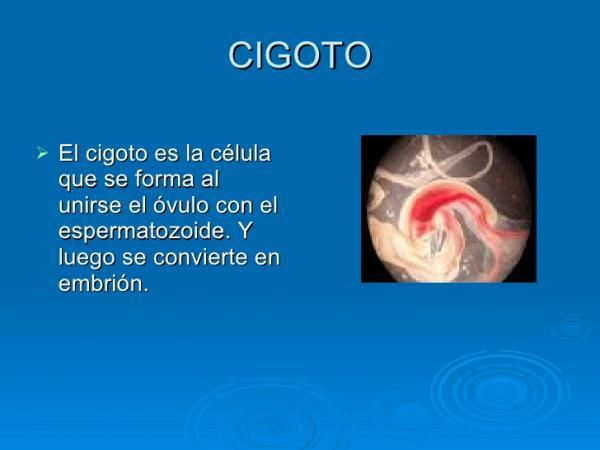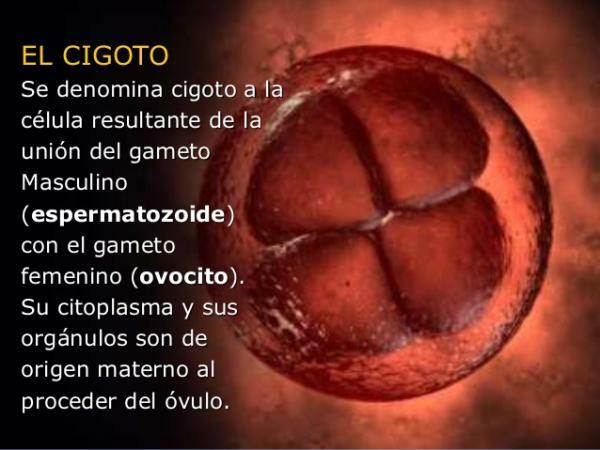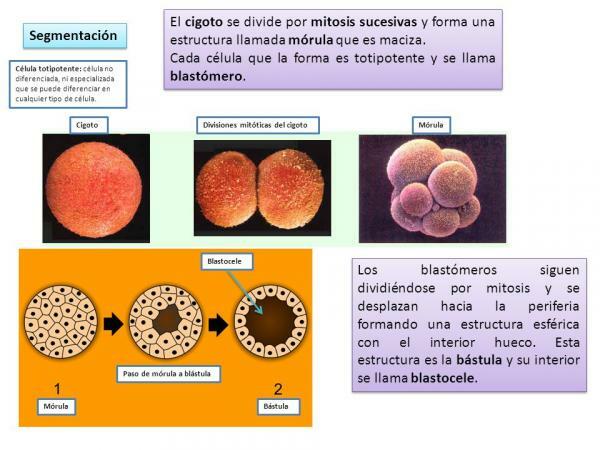Discover how the ZYGOTO is FORMED

Image: Slideshare
When we face the reproduction study, one of the first obstacles we encounter is to differentiate some terms that may be very similar to us at first: zygote, embryo and fetus. In this lesson from a TEACHER we will talk about how the zygote is formed, the first cell that arises as a result of fertilization and that we could consider as the first of the new living being. In this lesson we will review what the zygote is and we will learn to differentiate it from the embryo and the fetus.
Index
- What is the zygote?
- What is the difference between zygote, embryo, and fetus?
- The formation of the zygote: step by step
What is the zygote?
To know how the zygote is formed, we first have to be clear about what it is. The zygote It is the cell product of fertilization, that is, of the fusion of the male and female gamete. Upon joining, both gametes release their nucleus, which contains their genetic material, and is called the male and female pronucleus respectively.
Therefore, the zygote is a cell diploid, which contains two copies of each chromosome, one from the mother and one from the father. At first, these two pronuclei are released into the cytoplasm of the zygote and it is not until later when they join and we can already talk about zygotic DNA. In addition to the genetic material, the zygote contains cytoplasm, which serves to obtain energy, and which is of maternal origin. The zygote also contains organelles, which allow you to divide and are also maternal origin.
Finally, the zygote retains one of the envelopes of the oocyte: the zona pellucida, which we will see has important functions.

Image: How to Get Pregnant Quickly
What is the difference between zygote, embryo, and fetus?
When we first face the in-depth study of the phases immediately after fertilization, we realize that there are many similar terms and that, if they are not explained to us clearly, they can be confused. Before seeing how the zygote is formed, we will look at the sequence of terms for pregnancies in women: the Fertilization gives rise to the zygote, then the embryo and finally the fetus, which once delivery occurs, is a baby.
The distinction between zygote and embryo is not very clearIt depends on the authors: there are authors who define the zygote as the cell product of the fusion of oocyte and sperm and, when it begins to divide, they consider it an embryo; in other cases, the zygote stage is considered to begin with fertilization but end with the formation of the blastocyst, a ball-like structure.
On the other hand, the differentiation between embryo and fetus is clear: in humans, an embryo ceases to be so when the eighth week of development ends and the ninth week begins. At this stage of development, the new being has already formed most of the organs important for its survival, although they are not yet fully mature. In fact, many of them will finish their development after delivery, during the first months of life.
If you want to know more about the differences between zygote, embryo and fetus, you can visit the lesson regarding Stages of the zygote.
The formation of the zygote: step by step.
We are already beginning to talk about the way in which the zygote is formed. Although it is not clear when this stage ends, one thing is clear: zygote formation begins when fertilization occurs, that is, the union of the female and male gametes. The fertilizationIt is a complex process, which includes several stages: once the sperm passes all the obstacles and reaches the fallopian tubes, encounters a layer of cells that surround the oocyte: the corona radiata.
- The spermatozoonIt has, in the outer layer of its head, a series of enzymes that allow it to break the jelly-like barrier that these cells create. Once this is overcome, it has to come into contact with the outer envelope of the oocyte: the zona pellucida. The most important functions of the zona pellucida are: to recognize the sperm as a cell of the same animal species, give way, and avoid the passage of more sperm (avoiding the polyspermia).
- Once the sperm binds to the zona pellucida, it is recognized and the release of a series of enzymes that cause the zona pellucida to break off and the sperm head to separate from the tail. This process is called acrosomic reaction.
- Then the sperm enters the oocyte for an area called fertilization cone and in the membrane there is a movement of different ions, which produce the membrane depolarization, similar to a switch that changes from "open membrane to fertilization" to "closed membrane", forming a second barrier that prevents polyspermia.
- Once the sperm nucleus is released into the oocyte, the chromosomes from both they duplicate, the surrounding membranes disintegrate and chromosomes unite with their counterpart respective: maternal chromosome 1 joins with paternal chromosome 1 and so on. Once attached, the chromosomes move (migrate) to one end (pole) of the cell to begin the division stages seen in the lesson Stages of the zygote.

Image: SlidePlayer
If you want to read more articles similar to How is the zygote formed?, we recommend that you enter our category of biology.
Bibliography
- López, N. (2010). The zygote of our species is the human body. Person and Bioethics. 14 (2). 120-140.
- Sadler, T. (2001). Langman's Medical Embryology. Editorial Médica Panamericana. 8th Edition.
- Ventura, P. and Santos, M. (2011). The beginning of life of a new human being from the scientific biological perspective and its bioethical implications. Biological Research. 44(2). 201-207.
- MSD Manual. Brown, Haywood L. (November 2016) Stages of fetus development. Recovered from https://www.msdmanuals.com/es-es/hogar/salud-femenina/embarazo-normal/etapas-del-desarrollo-del-feto



